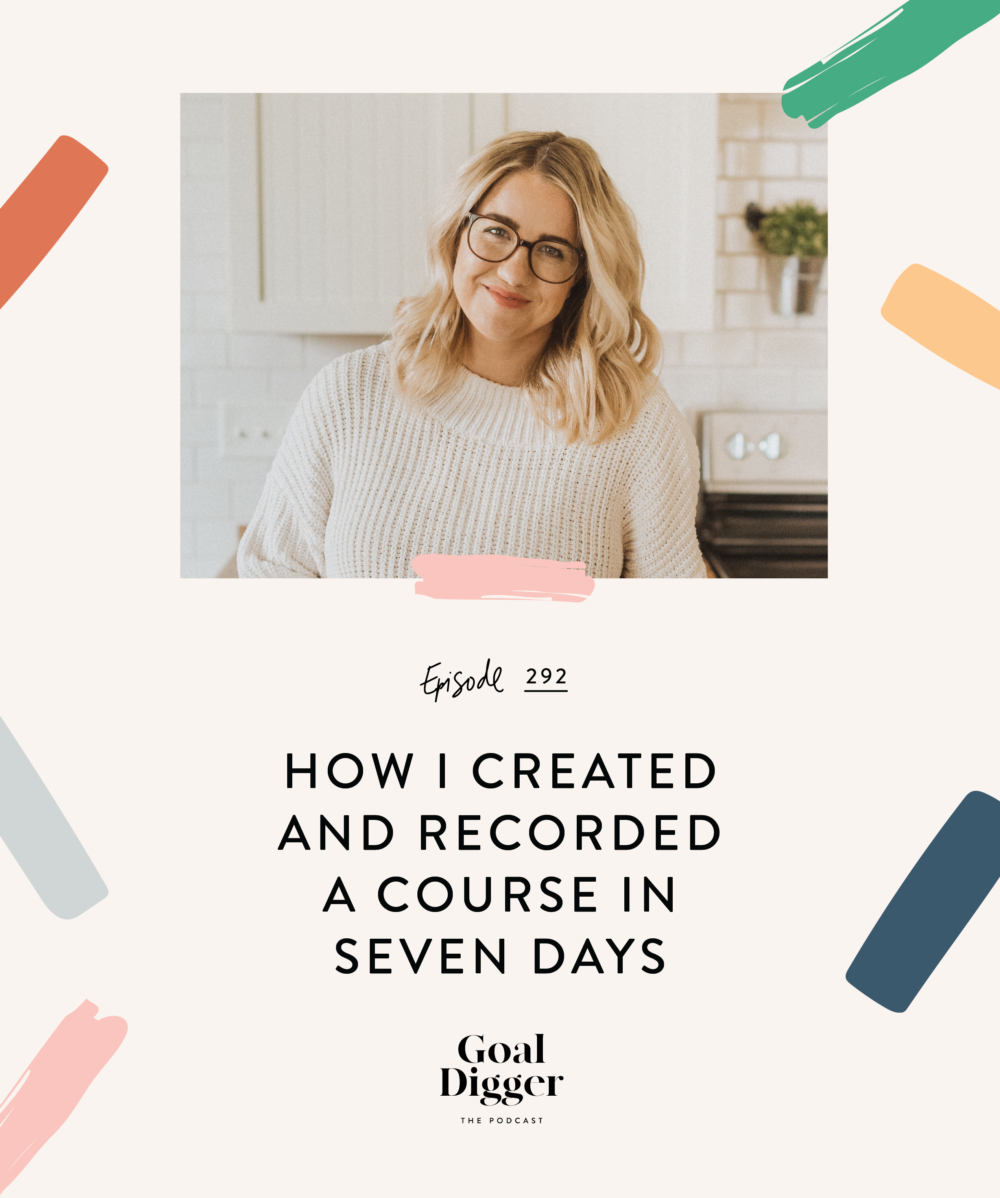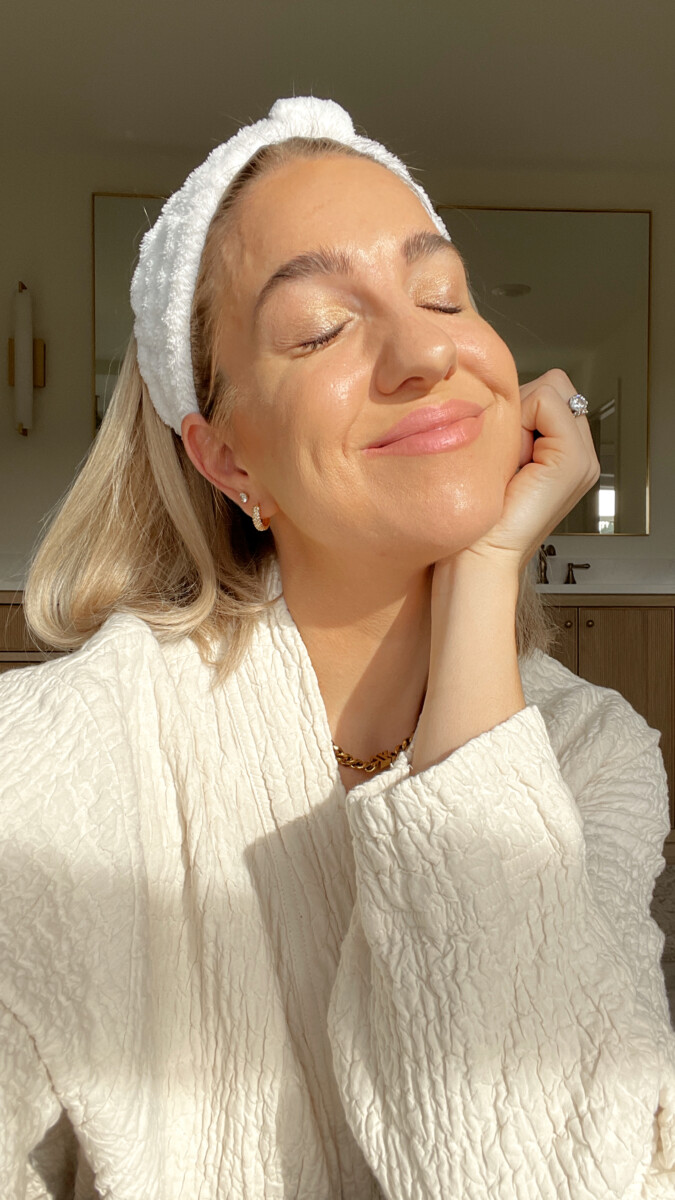
Tune in: Apple Podcasts | Spotify | Stitcher
If you know me, you know I like to move fast. From hiring to pushing content out into the world, I go before I am ready and make decisions quickly, I lean on gut intuition, I pivot at lightning speed on instinct, and I believe that done really is better than perfect.
I don’t like to wait around for life to happen to me. Life’s so short and there are so many opportunities out there, and I find it to be a blessing that I’m a fast thinker and decision maker. It’s allowed me to chase down dreams and be okay if I do make a mistake, because I know I’ll bounce back and make another quick decision to get right back on track.
There was one thing I did recently that was hype speed, even for me… I created and recorded a brand-new course in 7 days flat.
Yep. Over the course of 7 days with the help of ONE team member, I conceptualized, mapped out, recorded, and put my own Jenna spin on my most recent new course, The Podcast Lab.
This feat is totally reachable and possible for you to achieve, too, even if you don’t have a team or experience creating courses.
I was on the phone with my friend Amy Porterfield and I was telling her how we did this and if you know Amy, she’s super methodical, a perfectionist in the best way, and she plans everything out perfectly before she shares it with the world. She told me, “Jenna, you HAVE to share this… one, because I want to listen, but two, because people think that taking a program takes a year — this could change the game.”
Amy is one of my dearest friends, the person on speed dial when it comes to business and she was my first mentor — like the first online course I took was created by HER. She is hosting free webinars all about the three behind the scenes secrets to digital course success — How to Build, Launch and Grow a Thriving Digital Course Business Without Hiring a Big Team, the Constant Overwhelm or the Momentum Crushing Question, “What the Heck Do I Do Next?” and I have my seat all pulled up to the table to learn from the master so I want to invite you to do the same.
Head to learnfromamy.com and save your seat. Learn from my mentor and right along side of me. I am SO pumped because not only is she teaching on her webinar but she’s sharing about her program the Digital Course Academy and she’s the ONLY teacher on the internet that I’ve purchased every program out there that she’s created, so since she only opens up this course once a year, I don’t want you to miss your chance.
Start with the End Result
The first place to start when creating an online program is determining an end result. One of the main questions I get asked over and over is some iteration of how to start a podcast, or what equipment I use, or how I picked my name or theme or how I get it out into the world and get people to tune in. Pay attention to the questions you get asked more than once, because that is where you hold to power to impact and inspire change.
Now before you trick yourself and think: well, yeah, I get asked about XYZ all the time but there’s already a million programs out there about that…
I am of the belief that there’s enough room for everyone in the online world. If you’re an expert in an area or have the ability to share your experiences and knowledge, you can start a course. If you take on a mentor who teaches you how to make a program that gets people real results? Then you’re using your knowledge or experience to make an impact AND you’re getting paid for it.
When you’re considering the course you want to create, think about what your customer will get out of it. I always start my courses by picturing the end result: what value will someone receive by purchasing, completing, and applying this course to their own life or business?
For the Podcast Lab, I wanted to give participants a 5-step process to plan, create, launch, promote, scale, AND monetize their podcasts in 30 days. Sounds like a lot, right? But the whole program can be completed in under a few hours… like in ONE day.
Want to know if your end result measures up to SMART goal analysis? Press play on the episode above for the full explanation.
Here’s the thing about starting with the end result, it gives people a ruler to hold up to your course to say, “Did this program live up to the promise?” It should be a really clear and simple yes or no and not deviate based on people’s perceptions or definitions of success. If you don’t give people that ruler of a promise, then they will hold your program up to their own idea of success and so it’s really important to paint that picture well for them.
What Should Your Course Cover?
Coming up with the idea for The Podcast Lab was fairly simple for me. Obviously I’ve been podcasting for a few years and had a good handle on the basics of getting set up, what kind of equipment to recommend, what to do, and what NOT to do along the way.
Creating a course doesn’t have to be this enormous undertaking where you offer participants the moon and the stars and everything in between. I would argue that we all know more than we think — we all have expertise in some area that could benefit others.
So before you start Googling or doing a ton of research about what people WANT to learn about or what else is out there or what the recent data show, first, sit down with a good, old-fashioned pen and notebook and do a brain dump. Literally write down all of the information that’s living in your head based on your experiences or profession or background.
What do people come to you with questions about? What do they commonly want your help with? What do you know? What have you learned? Write it all out. For me, I started a Google Doc with one person on my team and we just started created a list of what steps I took to launch my show and then we started to just fill in blanks.
I used to do tons of research on the content I was creating and it would muddy my brain, it only invoked doubt and make me halt all progress. Have you ever done that? Where you research something to the point that you can remember up from down and you walk away feeling like you’re not even close to an expert? Knock it off! Sometimes the best thing you can do is put your head down and stay in your lane and there’s NO way I could have created a course in one week if I had started on research.
Research is encouraged, of course, but it’s not where I’d begin. If you know something works because you’ve seen it work, don’t go out of your way to do more “research” and add more unnecessary work for yourself.
Let me give you one tip — if you only hear this listen up — DON’T OVERCOMPLICATE IT. A course doesn’t need to be this giant directory that answers every question on every topic in the world. Truth be told, I am most attracted to programs that are SUPER simple, and that’s how I build mine out, too. I want people to get through it in a day or two so they can get results faster.
When to Do Your Research
So once I determine the course I want to create, I first do a big brain dump of what I know and of my process, THEN I do my research on other similar programs out there. For The Podcast Lab, I looked for other courses that taught about creating podcasts and specifically tried to find if they were lacking anything that I could offer — I set a timer for ONE hour and did my research on what was already out there and that was IT.
Don’t let this consume you but DO take a few minutes to see what’s on the market to give you confidence to put your own mark on it. Look for feedback or reviews, and see if there’s anything specific you can fill in holes for or add a new spin to.
We actually found there were only a few podcasting courses out there, and many of them didn’t cover promotion or marketing, many were taught by men, and a lot of the content was overcomplicated and overwhelming for someone who just simply wants to start and start quickly without a major investment.
Very few covered monetization or launch strategies, especially in great detail or length. Those are things I am super passionate about and so while simply starting a podcast is great, if you want to market or monetize that, you need the steps and tools to do that too! I made sure to rock those modules since most courses glazed over that content or missed it altogether.
Start Creating
Once I landed on the final result for The Podcast Lab, it sort of became the tagline: The Podcast Lab: It’s Your 5-step Process to Plan, Create, Launch, Promote, Scale, and Monetize Your Podcast in 30 Days.
The first step in actually creation the content is breaking it down. After coming up with our end result and making sure it was specific, measurable, relevant, attainable, and timely, we broke the overarching goal into 5 main steps that would then become the modules. I aim for each of my programs to be either a 3-step or a 5-step process, I feel like it helps give a starting point, a middle, and an end and based on how simple or complex the program will be, it gives a good structure to help people understand the undertaking when they join.
Go back through that brain dump you did and start organizing the information and laying out each step logically so you can see that start, middle and end that will naturally become the main structure of your course. Each step is a significant piece of the puzzle to launching a podcast, and they are: planning, recording, publishing, launching, and monetizing — makes sense, right?
And this doesn’t mean that we did just 5 huge lessons or modules, within each step, there are smaller sub-steps that we then broke down and listed out so that a user can quickly and easily consume the exact content they need vs. watching hour long modules waiting for that one piece that they really needed. We try to keep each lesson between 5 and 20 minutes because it’s easier to complete and consume.
Post-It Note Curriculum Planning
This is one of the best hacks and secrets in creating curriculum. A lot of times when you get the brain dump down, it kind of just looks like a jumble of information, so I do my best to get the main overarching topics down and I’ll write them on post it notes and then, if I’m really fancy, I’ll grab a different color or size of post-its and I’ll keep on breaking it down to know which lessons will go into those 5 main buckets that I defined as the steps needed.
Once I have all of those written on post it notes, I’ll sit at my kitchen island and categorize based on order of steps and what makes sense. It helps me to see it all and rearrange without confusing myself. Like, I legitimately like to map out courses using Post-it notes and I write down every single step people will need to do. Start to lay out an order that you can change and edit as you start to create the content that will fill each module. If you’re feeling stuck on the curriculum piece, this just might be the hack that changes that for you!
Organizing Micro-modules
Inside of each of the 5 main steps, we created a breakdown of the nitty gritty details so that nothing was glazed over or forgotten. I realize that not everyone needs every step but I want to make sure we include all the tiny things that might trip you up.
The benefit of micro-modules vs. doing really long, drawn out modules is that if you ever edit our update those modules, it’s far easier to update a 5 minute module than re-record a 60 minute walk through.
We ended up creating these micro-modules, or short little lessons to keep things super digestible. This also helps people to pick, choose, and consume only the content they really want and need. It kind of organizes it from this really great birds’ eye view so that users can really personalize their experience within each module — like choose your own adventure style but for learning.
For example, if they already had a recording set up, they could skip that section and move on instead of being stuck watching a 30-minute module and wondering when the content would actually apply to them.
Write a Script
After laying out the main modules and the lessons within them via sticky notes, we started creating the scripts. I write my scripts in Google Drive and start typing the EXACT information that I need to communicate. I write as though I’m having a conversation with a friend, which makes it a whole lot easier to record and easier for viewers to follow because it’s an approachable tone.
If you struggle with writing in this way, one idea is to voice record yourself teaching or explaining something and then either get it transcribed by someone for a few bucks or sit down and re-listen and make a script based on your recording. At this point, I use scripts for things like these shows so I make sure I stay on topic and deliver on our promises — so scripts are second nature but essentially I just sat down and created the meat of the course once I had the framework in place.
I’ll take those paragraphs and break them up into small chunks that will be the narration of each slide on our presentation. I go slide for slide giving 1-3 sentences per slide and create that script right in a Google Doc. The nice thing about scripts is you don’t get flustered and you can deliver specific content in a really quick and concise way.
Creating Slides
Once we build out the scripts, I create the slides. I have ONE keynote template that was designed professionally for my brand, and I use it for every single course I create. I paid a few hundred dollars and had a designer make me a beautiful template that has about 20 slide designs that I can plug my content into and I keep things super uniform and cohesive.
Since I had the scripts done and written out, I could create keynote presentations really quickly for each module. The slides should be incredibly simple. They should really only have a handful of key bullets or short and sweet sentences on them covering the main takeaway or point.
Creating the slides should be a relatively easy part of the process if you have a decent template to work off of and note that this is NOT where you totally rewrite the script and purge all of the information that you have.
If it’s your first course, I would suggest creating your own template on Keynote if you’re tech handy, or hire a designer for an affordable flat fee to get a nice branded template that you can use over and over again. Keynote is my choice but Powerpoint works just as well, too!
Time to Record
After the script was written and the slides were made, everything was good to go to start recording the course! When the day came to record, the house was a little busy with the dogs running around and the baby squealing. To get a little quiet time to record the entire course, I literally paid $200 and checked myself into a local hotel for a weekend to dedicate undistracted time to recording the entirety of the course. It was way easier for me to have a quiet space to knock it out and focus on getting the whole thing done.
All I brought with me to the hotel was my microphone, my little microphone sound reducing box, headphones, my computer, and my iPad. The iPad wasn’t necessary, but if you have one, it’s nice to use for scripts as you narrate the slides. And then I recorded each module in Keynote. I would save the screenflow file in case I needed to do any future edits and then save the finished video file.
It only took me 4 hours to record each little lesson and I used Screenflow while I narrated my slides using my scripts and so it was pretty easy once I got set up since I had prepared each piece ahead of time.
And while I know it’s not possible for everyone to check into a hotel to get work done, I would encourage you to ask for support from people in your life to be able to pursue the dreams on your heart. I have a plan to book a hotel room once a month or once every few months because it’s cheaper than getting an office space. I wanted to share this because it’s a main reason I was lucky enough to be able to create this course in a week and maybe something you’ve never considered as an option!
Upload Your Content
After recording was complete, I uploaded each lesson of my course to my FAVORITE platform of choice — the only one I’ve ever used for my courses — Kajabi. I saved all the files while recording into a folder on my computer and then once they were all recorded and edited down, then I took the time to upload, add descriptions, choose a cover image and so on.
This is the most fun part of the process because you get to see it all come to life and Kajabi makes it look so beautiful and professional for you. They take all of the hard work out of it and help you create a beautiful, easy-to-take course for your students. I can’t recommend them enough.
Voila! That’s all it takes to create a course, and in this case, it took only 7 days from conceptualization to recording and uploading. You can always make edits and changes down the line, so don’t stress about going over it 102 times before you push it out.
The Big Picture
Remember, nothing is final, so it’s better to get it done and out there than to hold on to that information that could bring so much value to others. Not sharing something with the world because it isn’t perfect yet isn’t what legacies are made of, friends. Taking messy action, sharing imperfectly, and being bold, THAT’s what I want my legacy to look like. I can’t wait to see what courses you create and use to change the world — all it takes is a little tapping into your gifts and knowledge, some planning, and a chunk of time to put it all together.
We Love Our Goal Digger Partners
Get $50 Off Your First LinkedIn Job Post
Get Your First Order of MeUndies for 15% off + Free Shipping





Love your podcast! I’m in the middle of creating a course right now so this is super helpful!
Where’s the Kajabi thing you told us about in the podcast? I was looking for it – thank you!
Do you have a list of your podcast equipment (microphone, sound box, anything else)?
[…] Some of the episodes are interviews with guests (mostly female), who are killing it in their spaces. The rest of the episodes are workshop style , getting geeky about specific topics like building your email marketing list, or creating an online course! […]
[…] How I Created and Recorded a Course in 7 Days […]
[…] How I Created and Recorded a Course in 7 Days […]
[…] Read/Listen to Jenna Kutcher here […]